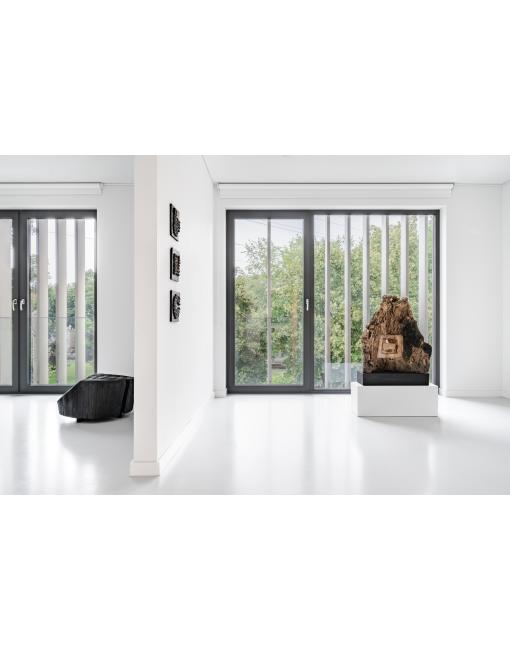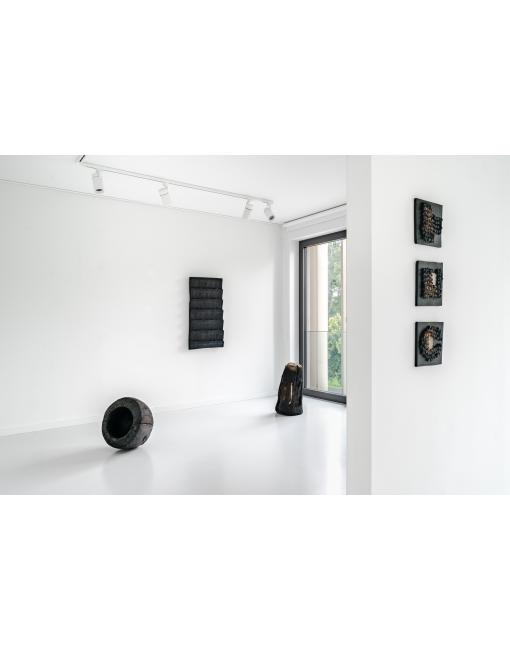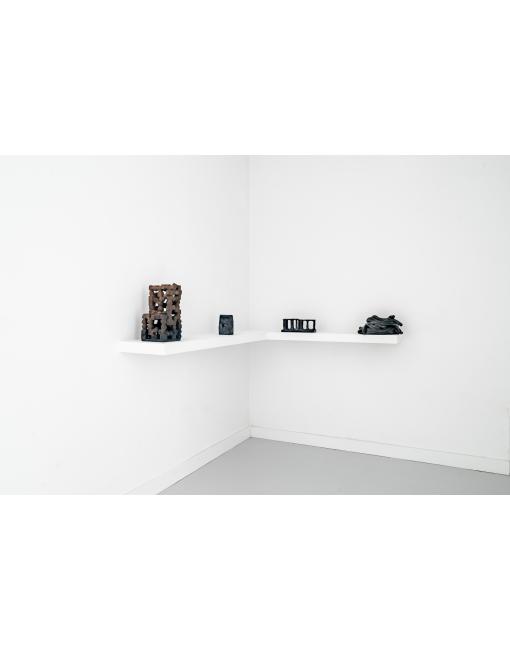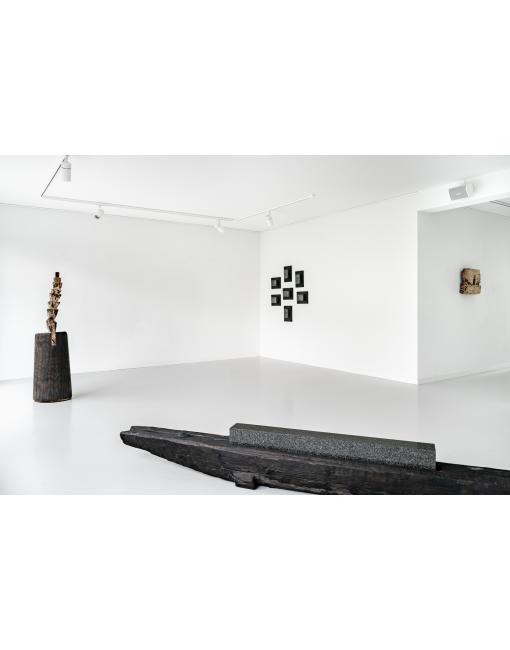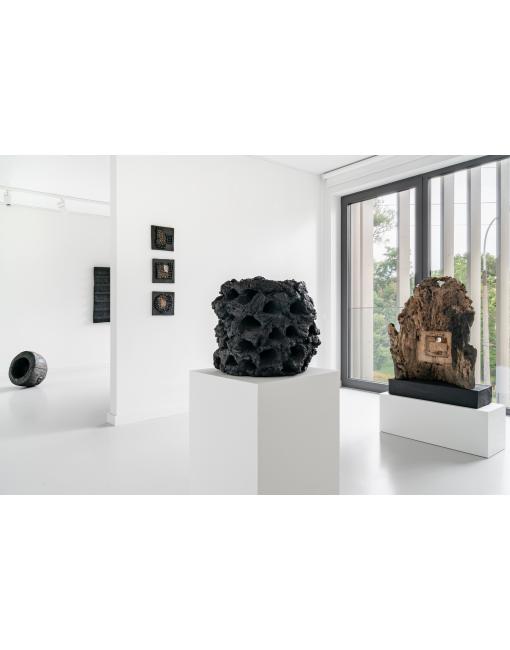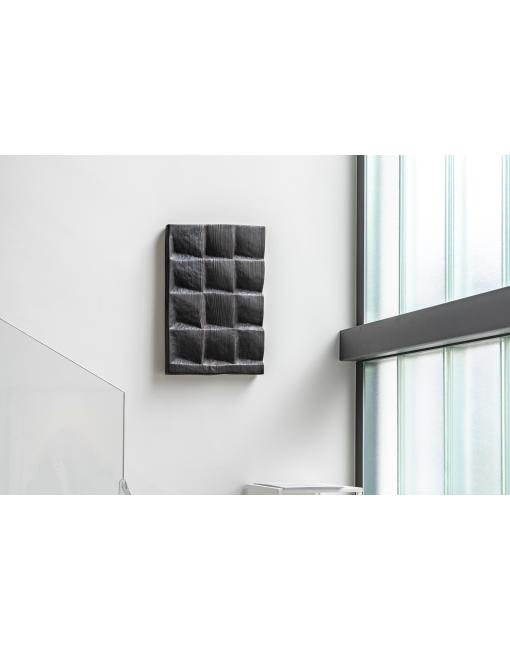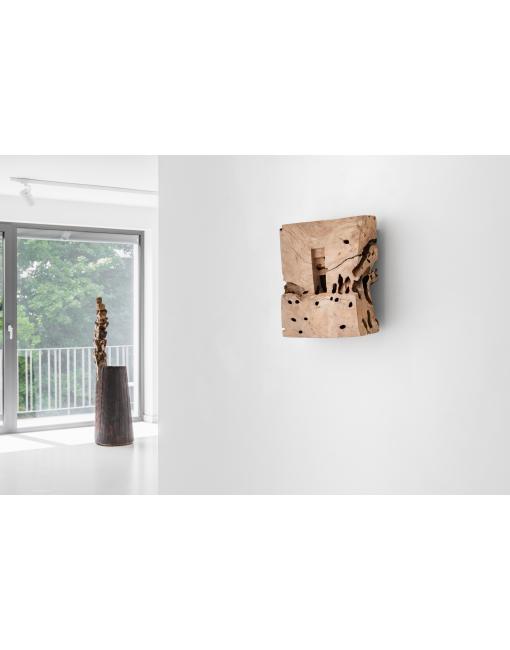Leszek Oprządek Collections and connections
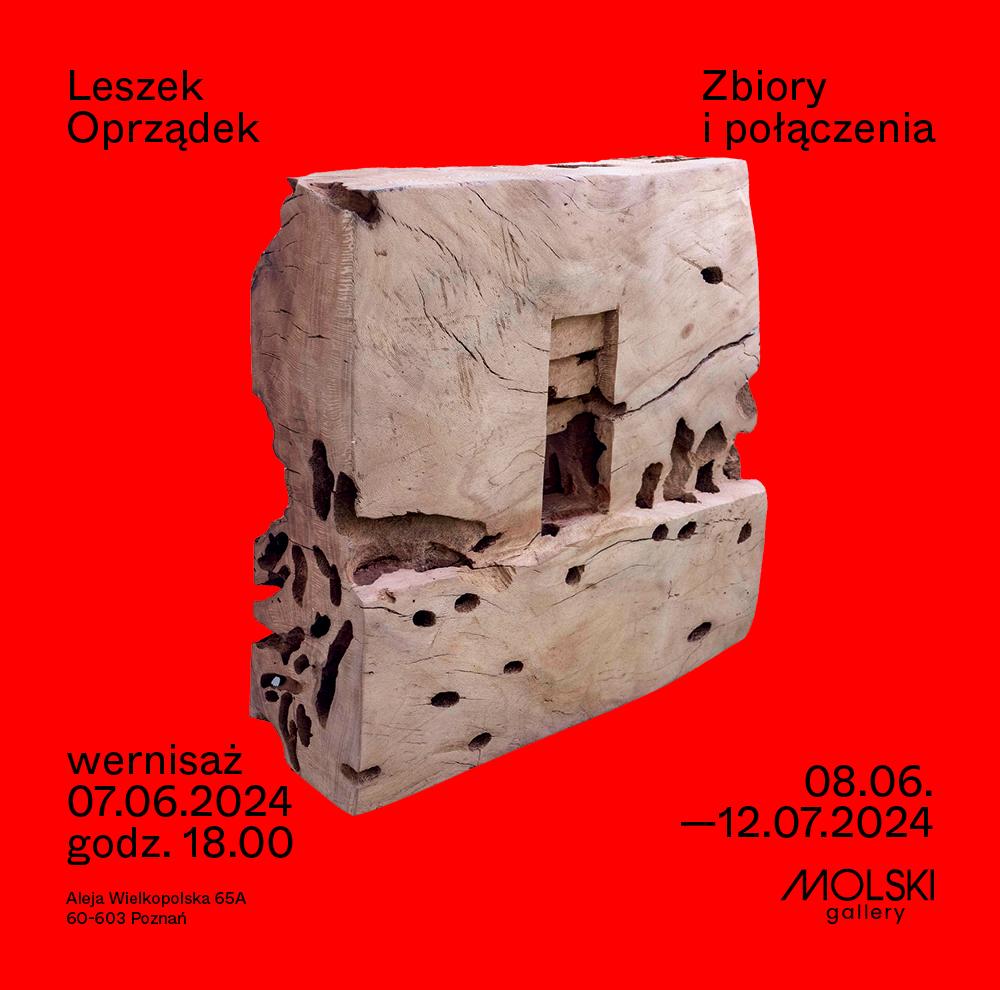
A Sign that Opens the Imagination. About the Sculptures by Leszek Oprządek
Agnieszka Tes
Leszek Oprządek entitled one of his artworks Reaktor. Perhaps there is some distant reminiscence of, for example, nuclear reactors, but I think the artist's intention was primarily to indicate that the work is an object that is meant to evoke a reaction: of the senses, of the psyche, of the imagination. In this sense, all of Oprządek's sculptures are 'reactors' of sorts. When I look at them, at first I do not place them within the currents of contemporary art, I do not assign them to one or another tendency; first there is always an association, a more or less distant association, a reaction of consciousness. Because these sculptures are like a sign that opens the imagination, they release something hidden in the reservoir of memory or in the depths of the psyche, without naming it explicitly, but like poetry, evoking it. So I imagine that in a black tree perforated with rhythmic hollows, congenially titled Night, one can hide from the world, immerse oneself in a boundless darkness. That the openwork structures or pillars have their origins in magaliths, Hindu lingams, ancient temples, and that the concrete punched, organic towers are thermitories or Cappadocian rocks. That the great boat laden with cargo is Charon's boat taking the error-laden life to the shore of the hereafter....
From conversations with the artist, I know that the first recipients of the sculptures usually also have some immediate associations. On the Greek beach, which for years has been his open-air studio and where he has excavated the outlines of some unspecified structures in the fragments of trunks he has found, people passing by immediately recognised Athos, the Meteora or the Parthenon in them, although they were certainly not direct models for the works. During a meeting with the artist, I became acquainted with various inspirations - for example, the oil mines in Krosno, the town of his childhood, or the films he watched, such as Mondo Cane with its cargo cult motif, a film image which later mysteriously contributed to the creation of a wooden boat with a stone cargo... However, the most important thing is not to find these specific traces, or to decode these motifs, not fully explained in their origins, sometimes idiosyncratic. Rather, the artist aims to trigger a process in the viewer, to put them in touch with areas displaced by a technicised present. And importantly, he sometimes manages to touch the archetypal sphere common to all, which makes the power of his works seem all the greater.
Allusions of form, openess of content
The exhibition at Molski Gallery brings together ceramic, wooden and concrete sculptures created in recent years, maintained in Oprządek's characteristic poetics of ambiguity and mystery, reaching back to archaic and archetypal connotations by means of aesthetics stemming from 20th-century explorations within abstraction. When asked about perceived affinities in the field of art, the artist mentioned above all Paule Klee and Eduardo Chillida, a Spanish sculptor whom he discovered for himself relatively late. Both the Polish artist and the figures he mentions have their own peculiarities, so it is difficult to unequivocally assign their achievements to specific directions on the artistic map. When thinking about Oprządek's works, it is worth being aware of their distinctive associative nature, which is immanently linked to their form and material. Another highly original feature of his works is the combination of austerity of artistic language with the breadth of the content it evokes. Finally, it is necessary to emphasise the fusion of the organic with the geometric and with what stems from elementary human experience, both in an individual and universal dimension.
In terms of form, the sculptor has a predilection for simplicity (sometimes even austerity), usually aiming for synthesis. Depending on the material, it appeals either by combining the irregular shapes of nature with geometry or flexibility, open-work interlacing or, for a change, compact concreteness. Oprządek often penetrates the spatial-compositional relations between the external and the internal, the empty and the full, the convex and the concave. On the other hand, he is keen to apply multiplications of elements, in effect creating piled-up rhythms or structures that are a kind of 'collections and connections'. In the case of works made in wood, characteristic holes and perforations appear, indicating the artist's predilection for scanning space and digging deep, as if in search of the essence of matter. On the other hand, an example of the compactness of form and excellent balance of material, which opens up to a vastness of association, is the already mentioned work entitled Cargo - a wooden boat carrying a granite block. The elongated, straight hull, which by the nature of its purpose should float gently, is weighed down by a solid stone and therefore doomed to go to the bottom. The paradox created in this sculptural composition is very meaningful, as it touches on the paradoxes of fate and life in general....
In some of the ceramic sculptures what draws attention is occurrence of a simple structural principle (as in some wooden works, e.g.: Meteora, Parthenonas), and therefore of supporting and supported elements (Tower, Double Form). The sources of inspiration here are not only travels and ancient buildings, but also the construction sites with which the sculptor's father was professionally involved, or the landscapes with the oil mine in his hometown of Krosno, dotted with the 'skeletons' of kivas, recurring in his memories. The shape of the ceramic sculptures also often takes on contrasting forms, can be flexible, tangled (Entanglement, Snakes), but also blocky (Carambol), vertical or "cellular". It has organic but also haptic qualities, triggering not only conceptual and content associations, but also specific sensations, bringing to mind: heaviness, softness, slipperiness, roundness, etc., so qualities found in nature. It seems that with the wide range of solutions that Oprządek explores in his creative practice, he is less interested in the question of the object itself in space, the interaction of the sculpture, the environment and the viewer, and more intrigued by touching certain rudiments of both the structures themselves and the sensation. In this area, the artist approaches both the way phenomena work in nature and ancient, archaic motifs, which of course does not exclude the creative use of the achievements of the last century's avant-garde, the search for as yet undiscovered 'symphonies of spatial arrangements'[1] .
In the layer of meaning, Oprządek, going beyond intellectual speculation, draws from a vast reservoir of sources, from the heritage of cultures or contemporary cultural texts (such as film), from childhood memories and spontaneously emerging impressions. Hence, his sculptures seem to accumulate the intuitions and needs of the psyche, while the characteristic forms of ceramics, wooden pillars or found tree fragments confront the viewer with hidden layers of consciousness. Many of the works displayed on the exhibition, for example, evoke a primal need for shelter, for finding a renewed connection to what has been eliminated by the dominant models of civilisational development. The sculptures are often associated with a penetration into the depths, a striving for cognition, they are a penetration and transgression of perceptual superficiality, they invite a change in perception, they suggest a process of transition, which may even be associated with a kind of initiation.
Nature and geometry
In this case, the starting point of the creative process is not an apriori idea born on an intellectual level, but an often seemingly insignificant impulse coming from the outside world: an image, a stone, a piece of found wood, a glimpse of an accidental arrangement of forms. Asked to speak on the occasion of the opening of the exhibition Collections and Connections at Molski Gallery, the sculptor emphasised that his art is not created with a sense of detachment from the whole but, on the contrary, immanently grows out of a relationship to nature and contact with it, out of a reading of the world as a kind of great, unchanging work in which we all participate. It is not surprising, then, that Oprządek chooses materials directly from nature and prefers techniques based on its components. In the wooden works, for example, the artistic intervention is directly inspired by the shapes given by nature and enters into a symbiosis with them, in no small measure preserving the legibility of the original appearance. The works shown in Poznań, such as the Parthenonas, the Gate and the Passage, can be recalled in this context. However, even when it comes to more decisive sculptural processing and finishing of individual objects by tanning the wood, giving them a subtle shade of black, the artist is far from academic smoothing of the surface, preferring "hard" carving of archaic or even primitive origin. And here let us recall sculptures such as Night, Reaktor, Charge, Cone or Grafting. Another example of the use of the richness of nature are the 'reliefs' presented in the exhibition made of rhythmically arranged beech nut shells, discarded by the sea and found by the artist on a Greek beach (Collection One, Collection Two).
No less strongly rooted in nature is ceramics, one of the oldest techniques known to mankind, to which Oprządek systematically returns. Its very use, of course, implies different solutions to those of wood or stone. There can be no question of using existing forms here; instead, it is necessary to model the amorphous clay. Here, too, however, the creator draws inspiration from the connections and laws that exist in nature, in the universe, and which operate on a micro- and macrocosmic level. The ceramicist's compositions therefore combine organicity with orderliness, plastic 'softness' with clearly perceptible construction, observation and knowledge with interpretation/creation. For many years, the sculptor was associated with the circle of geometrists centred around Bożena Kowalska, but he never practised art based solely on a geometric idiom, dominated by mathematical precision often coupled with aesthetic "sterility" and intellectualising/idealising the sphere of sensations. Nevertheless, in Oprządek's thinking about form and structure, discipline is present, a search for rhythms, repeating patterns, ordering principles that permeate existence and which should be reflected in sculpture, understood as part of a great whole, the All. The organic thus enters into dialogue with the geometry and structure, the feminine principle with the masculine, and the final form of the work seems to be the original resultant of many factors, inspirations and the complexity of the artist's inner world.
[1] Quote from the artist’s self-commentary.
Exhibition: 08.06 - 12.07.2024


